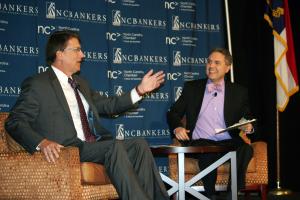Publisher's note: The author of this post is Dan Way, who is an associate editor for the Carolina Journal, John Hood Publisher.
'Safe harbor' credits could cost nearly $1 biillion, five times more than projected
CJ Photo by Barry Smith
Gov. Pat McCrory, at left, fields questions from Time Warner Cable News' Tim Boyum Wednesday during an economic forum at RTP.
RALEIGH State officials, lawmakers, and renewable energy consultants attempted Tuesday to downplay the $937.8 million cost of tax credits sought under the state's new Safe Harbor Act - a total more than five times higher than initial projections.
Members of the Joint Legislative Commission on Energy Policy also discussed who would monitor compliance for those receiving the 35 percent state tax credit for renewable energy investment and how rigorous that process would be. Some worried the program will be a drain on state finances that will provide large banks and insurance companies a windfall at the expense of taxpayers.
"It's the first time I've seen the numbers, to be honest about it," state Sen. Bob Rucho, R-Mecklenburg, said after the meeting. In December Carolina Journal
reported the $937 million estimate, provided by the state Department of Revenue.
Rucho was a primary sponsor of the bill allowing renewable energy companies, under specific restrictions, to remain eligible to claim the tax credits after the credit program expired Dec. 31.
"The $937 million is exorbitant," Rucho said.
"I don't believe that is a real number."
When the legislation
was debated in April before the Senate Finance Committee, Jonathan Tart of the legislature's Fiscal Research Division said applications would be limited mostly to
"four very large projects of approximately 100 megawatts each, and another one for 65 or 75 megawatts" at a cost of $183.5 million.
As it turned out, 201 applications and $1.9 million in application fees
were submitted to the state Department of Revenue by the Oct. 1 deadline.
"The applications suggest a much higher level of participation in the Safe Harbor than we knew about or projected at the time the legislation was passed," Tart told commission members Tuesday.
"Going down the road, you're just not going to know" the actual fiscal impact for some time.
Rucho said he anticipated only 50 to 60 percent of the credits would be taken.
"The data that we looked at showed 50 to 60 percent of available installments in a given year are actually used," Tart confirmed. That does not mean the full tax breaks won't be received.
"That meant they would have to be carried forward."
Under the Safe Harbor Act, the tax credits can be spread out over a decade, Tart said. A recipient of the credit may use it to offset no more than 50 percent of tax liability in a single year. Instead of losing part of a credit if it exceeds the 50 percent threshold, the tax break can be pushed forward.
"It's probably not going to be quite to the level of what's suggested by the applications," Tart said of the projected tax credits. If some projects aren't pursued, or don't meet requirements of the Safe Harbor Act, those tax credits won't be issued.
Thomas Boothby, a renewable energy industry accountant with Dixon, Hughes, Goodman of Charlotte, said his company has worked to varying degrees with roughly half of the Safe Harbor applicants.
"My estimate is that probably three-quarters of those applications that we're spending time working on are for projects that were placed in service by Dec. 31, 2015. So in reality, was the Safe Harbor law necessary for those projects to have received credits?" Boothby said.
"It would not have been."
His firm's clients saw the act as
"a well designed insurance policy" in case weather delays, a backlog of permitting, or some unforeseen setback at the very end of the project
"would have prevented tax credits from being delivered."
It was unclear from Boothby's testimony how many of those projects were in the pipeline when the Safe Harbor Act was passed, and why the numbers provided then by Fiscal Research were so far off.
The gap between projections and applications prompted Rep. Ken Goodman, D-Richmond, to wonder how the fiscal note got written, and whether its numbers presented a realistic cost to the state.
"Undoubtedly a portion of those 200 or so applications that were filed will be for projects that maybe never materialize," Boothby said.
"It's just too early to tell."
Developers must certify by March 1 they qualify for the tax credits, according to Nelson Freeman, Revenue Department legislative liaison, but total credits actually taken would not be disclosed until the Revenue Department releases its 2018 Economic Incentives Report.
To be eligible, Freeman said, a project smaller than 65 megawatts must have incurred costs and partial construction of at least 80 percent. Projects 65 mw and larger must have been 50 percent complete to qualify for the credit. An independent engineer and certified public accountant must submit notarized copies of written reports verifying eligibility.
House Majority Leader Mike Hager, R-Rutherford, asked about the Revenue Department's level of vigilance and review of those reports.
"There is no exception or additional requirement for examinations or audits," Freeman said.
"The dartment certainly does not have the capacity or knowledge" to do that.
Hager also expressed his disapproval that companies receiving tax credits for investments in renewable energy projects can sell or transfer them to other parties.
Hager said Duke Energy, Blue Cross and Blue Shield, Bank of America, and other large banks and insurance companies
end up with most of the tax credits.
The renewable credits are "a sweetheart deal," Rucho said. "It doesn't seem very fair that the taxpayers are picking up the burden that should be done strictly by the private sector."
Rep. John Szoka, R-Cumberland, took issue with Rucho. He said renewable energy companies have spent at least $2.6 billion in qualifying expenses alone in North Carolina, and more in ancillary costs.
"The tax revenue isn't really lost because if you were not doing this, [revenue would be] zero anyway. And then the economic activity that this is generating in the billions of dollars, which personally I think is a good thing," Szoka said.























